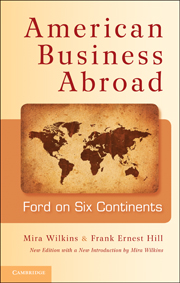Book contents
- Frontmatter
- Contents
- List of Illustrations
- Preface
- Introduction to the New Edition
- Introduction to the First Edition
- 1 First Venture
- 2 Probing for Markets
- 3 Model T: Triumph and Fable
- 4 The Alchemy of War
- 5 Steps in Expansion
- 6 The Sun Never Sets
- 7 Prosperity and Frustration
- 8 The Missionary Spirit
- 9 The Best-Laid Plans
- 10 Marriage of Convenience
- 11 Time of Desperation
- 12 A World Disturbed
- 13 Extreme of Nationalism
- 14 The British Empery
- 15 On Both Sides of World War II
- 16 The Crippled Phoenix
- 17 The New Company
- 18 Manufacturing for World Markets: From Dagenham to Geelong
- 19 New Times, New Faces, New Policies
- Appendices
- Bibliographical Essay
- Notes
- Index
- Titles in the series
- Plate section
7 - Prosperity and Frustration
Published online by Cambridge University Press: 05 June 2012
- Frontmatter
- Contents
- List of Illustrations
- Preface
- Introduction to the New Edition
- Introduction to the First Edition
- 1 First Venture
- 2 Probing for Markets
- 3 Model T: Triumph and Fable
- 4 The Alchemy of War
- 5 Steps in Expansion
- 6 The Sun Never Sets
- 7 Prosperity and Frustration
- 8 The Missionary Spirit
- 9 The Best-Laid Plans
- 10 Marriage of Convenience
- 11 Time of Desperation
- 12 A World Disturbed
- 13 Extreme of Nationalism
- 14 The British Empery
- 15 On Both Sides of World War II
- 16 The Crippled Phoenix
- 17 The New Company
- 18 Manufacturing for World Markets: From Dagenham to Geelong
- 19 New Times, New Faces, New Policies
- Appendices
- Bibliographical Essay
- Notes
- Index
- Titles in the series
- Plate section
Summary
Edward Grace, manager of the Cork plant, came to Detroit in May 1923 to discuss the situation created by the English tariff on Irish products. As already noted, this had made the manufacture in Cork of car parts for Manchester economically impossible and posed a double dilemma. There would have to be a new future for the Irish plant, and Manchester must get duty free the engines and castings it had been receiving from the factory. The decision was “for the time being motors and axle assemblies will be manufactured at Cork.” But it was understood that “Cork is to stop manufacturing as soon as it is possible to secure a suitable site in England and erect buildings necessary to accommodate our Cork equipment.” Edsel Ford and Sorensen deputized Grace to scour England and find a location for the new manufacturing center.
It will be recalled that Henry Ford owned land at Southampton, but was not inclined to build there. Grace, with C. L. Gould, manager of the English company, now looked for a better site and soon reported that “after having thoroughly investigated England … the most suitable place for the future plant is in the London district—somewhere in the neighborhood of Dagenham.” For the first time, on July 10, 1923, that name was laid before Ford officials in the United States.
- Type
- Chapter
- Information
- American Business AbroadFord on Six Continents, pp. 134 - 161Publisher: Cambridge University PressPrint publication year: 2011

